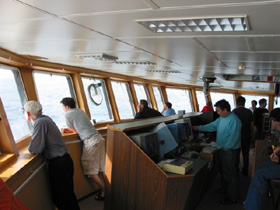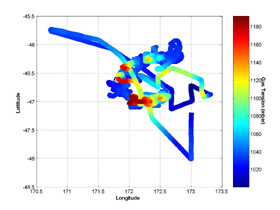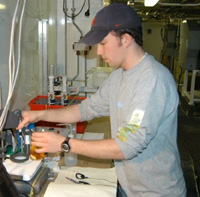Cruise
Log: Saturday, April 10, 2004
|
March
|
|
Sun
|
Mon
|
Tue
|
Wed
|
Thu
|
Fri
|
Sat
|
|
|
1
|
2
|
3
|
4
|
5
|
6
|
|
7
|
8
|
9
|
10
|
11
|
12
|
13
|
|
14
|
15
|
16
|
17
|
18
|
19
|
|
|
|
|
|
|
|
|
|
|
|
|
|
|
|
|
|
|
April
|
|
|
|
|
|
|
|
|
|
|
|
|
|
|
|
10
|
|
|
|
|
|
|
16
|
17
|
|
18
|
19
|
20
|
21
|
22
|
23
|
24
|
|
25
|
26
|
27
|
28
|
29
|
30
|
|
|
| |
 |
| The
science party helps Yoshi and the rest of the crew scan the horizon
for the CARIOCA buoy (Photo by Matt Walkington). |
| |
 |
| Stream
plot of total dissolved gas around the eddy. High values correspond
to high wind speeds (Credit: Dave Katz). |
| |
| |
| |
| |
| |
 |
| David
Katz performs a Winkler Titration for oxygen concentration of seawater
(Photo by Matt Walkington). |
Steaming
Onwards
After a couple of
pre-dawn CTD casts this morning, we slowed down to make measurements in
the vicinity of the French CARIOCA buoy. We have finally left the patch
that we've spent nearly three weeks chasing around this area of the South
Pacific. We started to see increases in the number of phytoplankton cells
toward the end of the patch experiment. It has been hypothesized that
once the many cloudy days finally broke into sunshine, the phytoplankton
were no longer light limited. But as always in science there are certain
to be other contributing factors to the growth limitation of the phytoplankton.
Possibly low levels of other trace metals besides iron contributed to
it.
We are now steaming to the first of two biophysical moorings that require
servicing. Here we will also be taking water samples for the same suite
of analyses that we have been performing on the patch water.
As for myself,
I've been continuously monitoring the amount of total dissolved gas and
oxygen in the surface ocean through the Tangaroa's seawater supply. I'm
also doing titrations for the analysis of oxygen, using the Winkler method,
to keep the oxygen sensors on the CTD and in my underway system in calibration.
Coming into this experiment
we expected to see significant increases in the amount of oxygen in the
ocean produced by active phytoplankton. The grazing by zooplankton has
seemingly kept pace with any increased phytoplankton biomass and as a
result this expected increase in oxygen hasn't been observed. The extreme
weather we've had during the experiment that was detrimental for the patch
in many ways was interesting for me however. It provides a unique opportunity
to directly observe how high winds affect the concentration of dissolved
gases in the open ocean. This increase happens as a result of breaking
waves creating bubbles that are mixed throughout the upper part of the
ocean and ultimately dissolve. Measurements of the dual tracers SF6 and
He3 during the times of high wind speeds provide an accurate estimation
of the gas transfer velocity, or piston velocity. Using the gas transfer
velocity measurements and the observed gas concentrations, we should be
able to test current hypotheses on how high wind speeds affect gas transfer
and concentration in the oceans.
Next Day >>
|